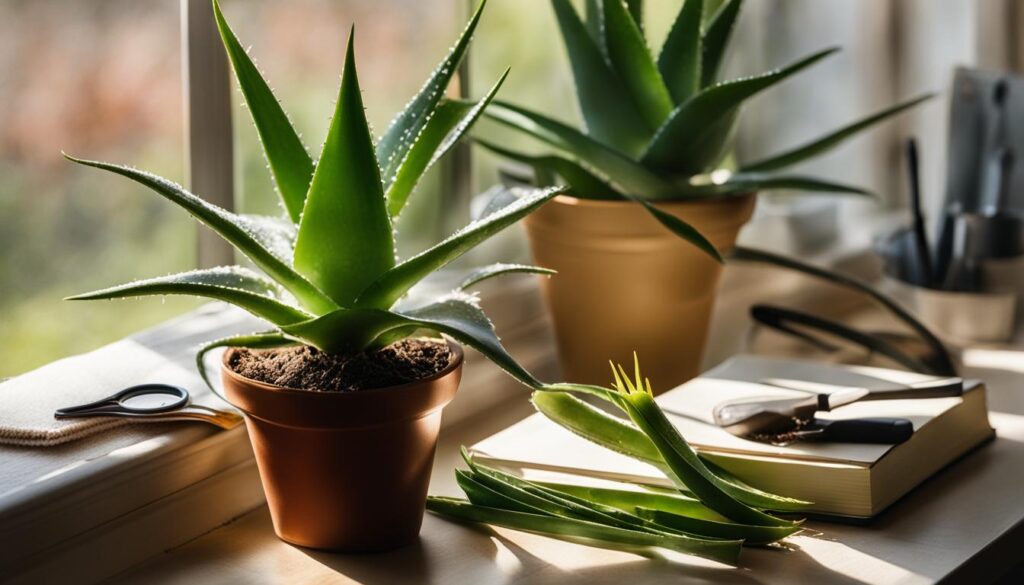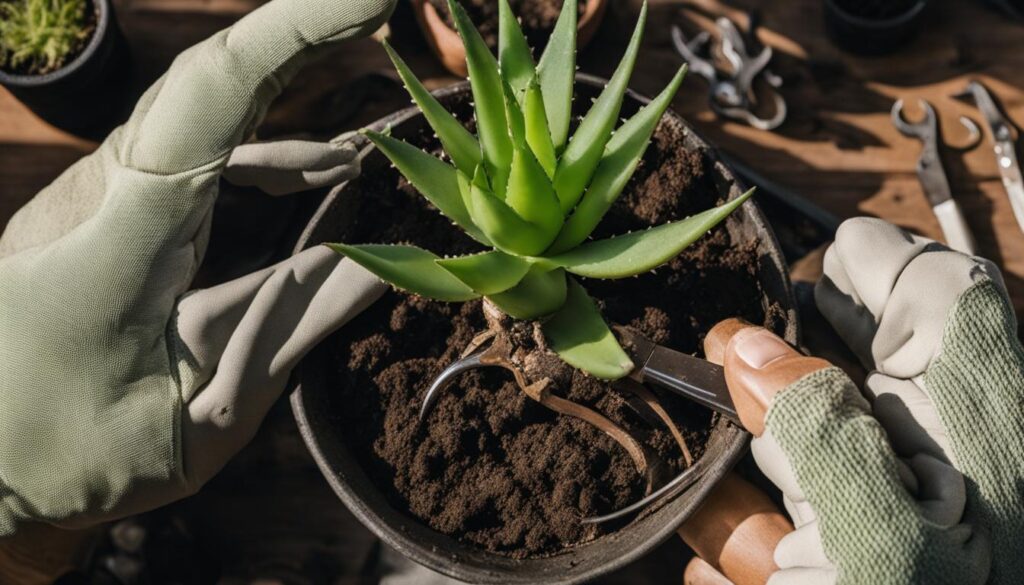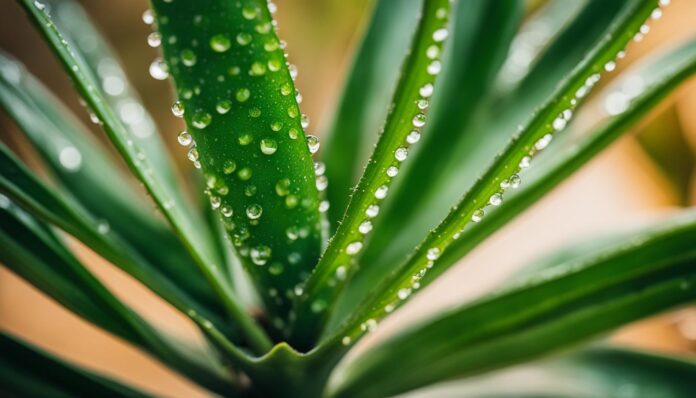Welcome to our beginner’s guide to Aloe Vera plant care! Aloe Vera is not only a popular houseplant but also a powerhouse of health benefits. For centuries, it has been revered for its ability to treat various skin irritations, thanks to its soothing and healing properties. In this comprehensive guide, we will cover everything you need to know about caring for Aloe Vera plants, from cultivation and maintenance to common issues and our top recommendations. Let’s dive in and discover the wonders of Aloe Vera!
Key Takeaways:
- Aloe Vera plants offer numerous skincare benefits and have a rich history in ancient civilizations.
- Proper care includes providing bright, indirect sunlight and well-drained soil for your Aloe Vera plants.
- Water your Aloe Vera plants sparingly, allowing the soil to dry out between waterings.
- Prune and repot your Aloe Vera plants regularly to maintain their health and appearance.
- Propagate Aloe Vera plants through offsets or pups to expand your collection.
What is Aloe Vera and its Benefits?
Aloe Vera, scientifically known as Aloe barbadensis, is a succulent plant that is native to southern and eastern Africa. It is known for its gel-like substance found within its thick, fleshy leaves. Aloe Vera gel has various medicinal and skincare benefits, including treating sunburn, mild burns, and skin irritations.
Its soothing properties help reduce inflammation and promote healing. Aloe Vera gel also acts as a natural moisturizer, hydrating the skin without leaving a greasy residue. It is rich in vitamins, minerals, and antioxidants that nourish and protect the skin from environmental damage.
Moreover, Aloe Vera gel is a common ingredient in skincare products due to its ability to soothe and calm sensitive or irritated skin. It helps alleviate dryness, redness, and itching, making it suitable for people with eczema or psoriasis.
In addition to its skincare benefits, Aloe Vera gel is used in haircare to promote healthy hair growth, reduce dandruff, and improve scalp conditions. It can strengthen and moisturize the hair, leaving it shiny and manageable.
To sum up, Aloe Vera and its gel offer a range of benefits for skincare and haircare. Whether used in its natural form or incorporated into various products, Aloe Vera can provide soothing relief and nourishment to enhance your overall well-being.
| Aloe Vera Benefits | Uses |
|---|---|
| Skincare | • Treats sunburn • Soothes skin irritations • Hydrates and moisturizes dry skin • Reduces inflammation and redness • Nourishes and protects the skin • Suitable for sensitive or irritated skin |
| Haircare | • Promotes hair growth • Reduces dandruff • Improves scalp conditions • Strengthens and moisturizes hair • Adds shine and manageability |
| Medicinal | • Treats mild burns • Relieves itching • Helps heal wounds and cuts • Eases symptoms of eczema and psoriasis • Provides antioxidant protection |
Growing and Caring for Aloe Vera Plants
Proper care is essential for the growth and health of your Aloe Vera plants. By understanding their specific needs, you can ensure that they thrive and beautify your space. Here are some important tips for growing and caring for your Aloe Vera plants:
1. Sunlight
Aloe Vera plants require bright, indirect sunlight to thrive. Place them near a window where they can receive ample natural light. Avoid exposing them to direct sunlight for prolonged periods, as it can lead to sunburn.
2. Soil
Well-drained soil is crucial for Aloe Vera plant care. Opt for a cactus or succulent mix that provides excellent drainage. This prevents the roots from sitting in water, which can cause root rot. Alternatively, you can create your own well-draining soil mix by combining sand, peat moss, and perlite.
3. Watering
Aloe Vera plants are succulents that store water in their leaves. They have low water requirements and prefer dry conditions. Water your Aloe Vera plants 1-2 times per week, allowing the soil to dry out between waterings. Overwatering can lead to root rot, so it’s important to avoid excessive moisture.
4. Climate
Aloe Vera plants are native to dry climates and prefer moderate temperatures. They can tolerate a wide range of temperatures but should be protected from extreme cold or heat. If you live in an area with harsh winters, it’s best to grow your Aloe Vera plants indoors or provide them with adequate protection outdoors.
5. Fertilization
Aloe Vera plants do not require frequent fertilization. They can thrive in nutrient-poor soil. However, if you choose to fertilize, use a balanced, water-soluble fertilizer specifically formulated for succulents. Apply it sparingly and follow the manufacturer’s instructions to prevent over-fertilization.
6. Indoor vs. Outdoor
Aloe Vera plants can be grown both indoors and outdoors, depending on your climate and preferences. Indoor plants should be placed in a well-lit area with proper ventilation. Outdoor plants should be given partial shade and protected from extreme temperatures and excessive rain.

| Aspect of Aloe Vera Plant Care | Summary |
|---|---|
| Sunlight | Provide bright, indirect sunlight |
| Soil | Use well-drained cactus or succulent mix |
| Watering | Water 1-2 times per week, allowing the soil to dry out between waterings |
| Climate | Protect from extreme temperatures |
| Fertilization | Optional, use a balanced, water-soluble fertilizer sparingly |
| Indoor vs. Outdoor | Adapt care based on location and climate |
Following these tips will help you create an optimal environment for your Aloe Vera plants, ensuring their long-term health and beauty. With proper care, your Aloe Vera plants can thrive for up to 12 years, bringing a touch of greenery and natural charm to your home or garden.
Pruning Aloe Vera Plants
Regular pruning plays a crucial role in maintaining the overall health and appearance of your Aloe Vera plants. By removing brown and brittle tips, you can promote new growth and ensure the plant’s vitality. However, it’s important to note that you should avoid pruning the center leaves, as these are the youngest and healthiest parts of the plant.
When pruning your Aloe Vera, exercise caution to retain at least 5-6 leaves. This ensures that the plant can effectively absorb sunlight, which is necessary for its growth and development. Pruning excessively or removing too many leaves can hinder the plant’s ability to photosynthesize, ultimately affecting its health.
To give you a better visualization of the pruning process, here’s a step-by-step guide:
- Inspect the leaves for any brown or dry tips.
- Using clean and sharp pruning shears, carefully trim the affected portions, making clean cuts just above the healthy green parts of the leaf.
- Avoid leaving stubs or jagged edges, as these can become susceptible to disease or pests.
Remember, pruning your Aloe Vera plants not only improves their appearance but also helps maintain their vitality and contributes to their overall well-being.
Pruning Aloe Vera Plants
| Pruning Steps | Benefits |
|---|---|
| Trim brown and brittle tips | Promotes new growth |
| Avoid pruning center leaves | Preserves the youngest and healthiest parts of the plant |
| Leave 5-6 leaves when pruning | Ensures adequate sunlight absorption |
Repotting Aloe Vera Plants
As your Aloe Vera plant grows, it will eventually outgrow its current pot. Repotting is an essential step in providing your plant with fresh soil and adequate space for continued growth. Here’s a guide on how to repot your Aloe Vera plant:
Gather your supplies
Before you begin repotting your Aloe Vera plant, gather the necessary supplies:
- A larger pot with good drainage
- A well-draining commercial potting mix or a mix of sand, peat moss, and perlite
- A small trowel or gardening tool
Prepare the new pot
Choose a pot that is slightly larger than the current one, as Aloe Vera plants prefer snug spaces. Ensure the pot has drainage holes to prevent waterlogged soil. Fill the bottom of the pot with a layer of potting mix, leaving enough space for the plant.
Remove the plant from its current pot
Gently turn the pot upside down and tap the sides to loosen the plant’s roots. Carefully slide the plant out of the pot while supporting the base of the plant. If the plant is firmly rooted, you can use a small trowel to gently loosen the soil.
Place the plant in the new pot
Position the plant in the center of the new pot, ensuring that the base of the plant is level with the rim of the pot. Add more potting mix around the sides, pressing it gently to secure the plant. Leave some space at the top for watering and growth.
Water the repotted plant
After repotting, water the plant thoroughly to help settle the soil around the roots. Avoid overwatering, as Aloe Vera plants are prone to root rot. Allow the excess water to drain out of the pot before placing the plant in a sunny spot.
Remember to wait until the soil is dry before watering the plant again. Overwatering can lead to root rot and other issues. A well-draining potting mix and proper watering practices are crucial for the health and happiness of your Aloe Vera plant.
Repotting your Aloe Vera plant every 2-3 years ensures that it has enough room to grow and access fresh nutrients from the soil. By following these steps, you can ensure the continued well-being of your Aloe Vera plant and enjoy its beauty and benefits for years to come.
Propagating Aloe Vera Plants
Aloe Vera plants can be propagated through offsets or pups, which are small replicas of the parent plant that form around the base of the main plant. Propagation is an excellent way to expand your Aloe Vera plant collection and share the benefits of this versatile plant with others.
To propagate an Aloe Vera plant, follow these steps:
- Carefully twist off a pup from the mother plant. Make sure to use clean and sterile tools to prevent any infections.
- Allow the pup to callous over for a few days. Place it in a shaded area and let the wound heal, forming a protective layer.
- Once the pup has calloused, repot it in a well-draining cactus mix. Use a pot with sufficient drainage holes to prevent waterlogging.
- Water the newly potted pup sparingly, allowing the soil to dry out between waterings. Aloe Vera plants prefer dry conditions, so be cautious not to overwater.
Propagation not only gives you the opportunity to grow more Aloe Vera plants but also helps you share the joy of plant ownership with friends and loved ones. It’s a rewarding experience to watch your propagated plants thrive and flourish.

By propagating Aloe Vera plants, you can enjoy the benefits of this remarkable plant while spreading its beauty and health benefits to others.
Common Issues with Aloe Vera Plants
Aloe Vera plants are generally resilient, but they can encounter some common issues. It is essential to be aware of these problems to ensure the health and vitality of your Aloe Vera plants.
Overwatering
One of the most common problems with Aloe Vera plants is overwatering. Excess water can lead to root rot, where the roots become waterlogged and begin to decay. Signs of overwatering include yellowing and mushy leaves. To prevent overwatering, allow the soil to dry out between waterings and ensure proper drainage.
Underwatering
On the other hand, underwatering can also cause issues for Aloe Vera plants. Lack of water can lead to dry and brown leaves. It is important to water your Aloe Vera plant when the soil is dry to the touch. However, be cautious not to overwater, as mentioned earlier.
Pests
Aloe Vera plants can be susceptible to pests, including mealybugs and spider mites. These pests can cause damage to the leaves and hinder the plant’s growth. It is crucial to regularly inspect your plants and take immediate action if you notice any signs of infestation. You can use natural or chemical remedies to eliminate pests and protect your Aloe Vera plants.
To ensure the health and wellbeing of your Aloe Vera plants, it is vital to provide them with adequate sunlight, use well-draining soil, and practice appropriate watering techniques. By addressing these common issues promptly and taking preventive measures, you can enjoy vibrant and thriving Aloe Vera plants in your home or garden.
Next, we will provide our recommendations and tips for optimal Aloe Vera plant care.
Our Recommendation for Aloe Vera Plant Care
To keep your Aloe Vera plants healthy, follow these recommendations:
-
Provide bright, indirect sunlight. Aloe Vera plants thrive in bright light, but direct sunlight can scorch the leaves. Place your plant near a sunny window or provide filtered light.
-
Water sparingly, allowing the soil to dry out between waterings. Aloe Vera plants are succulents and store water in their fleshy leaves. Overwatering can lead to root rot, so it’s best to let the soil dry before watering again.
-
Use a well-draining potting mix and a pot with good drainage. Aloe Vera plants prefer soil that drains well to prevent waterlogged roots. A mixture of cactus soil and perlite works well.
-
Prune regularly to maintain plant health and appearance. Remove any brown or dried-out leaves to encourage new growth. Avoid pruning the center leaves, as these are the youngest and healthiest.
-
Repot every 2-3 years for fresh soil and increased space. Aloe Vera plants appreciate being root-bound, but eventually, they will outgrow their pots. Repotting provides fresh soil and allows the plant to continue growing.
-
Propagate through offsets or pups to expand your plant collection. Aloe Vera plants produce small offsets or pups around the base, which can be removed and planted in their own pots. This is a great way to propagate and share Aloe Vera plants with others.
By following these care tips, you can ensure the health and longevity of your Aloe Vera plants, allowing you to enjoy their beauty and reap the benefits they offer.
Conclusion
In conclusion, caring for Aloe Vera plants is a rewarding and straightforward process that can bring beauty and wellness to your home. By following the recommended care practices outlined in this guide, you can ensure the proper growth and longevity of your Aloe Vera plants.
Providing the right amount of sunlight and maintaining a regular watering schedule is key to keeping your plants healthy. Remember to use well-draining soil and pots with proper drainage to prevent waterlogged roots and potential rotting.
Regular pruning and repotting every 2-3 years will help maintain the health and appearance of your Aloe Vera plants. Additionally, propagating them through offsets or pups allows you to expand your plant collection and share the benefits of Aloe Vera with others.
With the right care, your Aloe Vera plants will thrive and provide you with their soothing and hydrating gel for various purposes. Enjoy the beauty and benefits of these versatile houseplants!
FAQ
What are the benefits of Aloe Vera?
Aloe Vera has various benefits for both health and skincare. It is known for soothing and hydrating the skin, treating sunburn, mild burns, and skin irritations. Aloe Vera gel is also commonly used in skincare and haircare products.
How often should I water my Aloe Vera plant?
Aloe Vera plants should be watered 1-2 times per week, allowing the soil to dry out between waterings. It is important to avoid overwatering, as this can lead to root rot.
Can I grow Aloe Vera indoors?
Yes, Aloe Vera plants can be grown indoors or outdoors. They require bright, indirect sunlight and well-drained soil. Indoor plants should be placed in a sunny spot near a window.
How do I prune my Aloe Vera plant?
Regular pruning is important for maintaining the health and appearance of Aloe Vera plants. Prune brown and brittle tips to promote new growth. However, do not prune the center leaves, as these are the youngest and healthiest parts of the plant.
How often should I repot my Aloe Vera plant?
Aloe Vera plants should be repotted every 2-3 years to provide fresh soil and more space for growth. Use a well-draining potting mix and a pot with good drainage when repotting.
How can I propagate my Aloe Vera plant?
Aloe Vera plants can be propagated through offsets or pups. Carefully twist off a pup from the mother plant, allow it to callous over for a few days, and then repot it in a well-draining cactus mix.
What are common issues with Aloe Vera plants?
Overwatering can lead to root rot and yellowing leaves, while underwatering can cause the leaves to turn brown and dry. Aloe Vera plants are also susceptible to pests such as mealybugs and spider mites.
What are your recommendations for Aloe Vera plant care?
To keep your Aloe Vera plants healthy, provide bright, indirect sunlight, water sparingly, use a well-draining potting mix, prune regularly, repot every 2-3 years, and propagate through offsets or pups to expand your plant collection.

